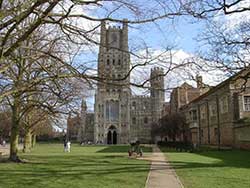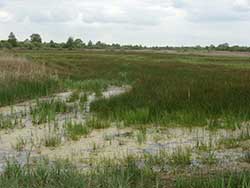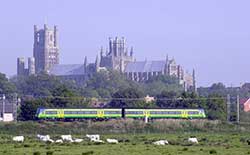|
Ely
by David Wright
 I have already written about my visits to two of England’s famous old cities, Durham and Lincoln. Now I would like to give you an account of my trip to another old cathedral city which lies in the south-east of the country in the county of Cambridgeshire1 in the region known as East Anglia. As the regional name suggests, this was the area nearest to present-day Germany whence came the ancient invaders, the Angles. You may have heard their name linked with another Germanic tribe who were also successful invaders who originated in Saxony, the pair being known collectively as the Anglo-Saxons.
I have already written about my visits to two of England’s famous old cities, Durham and Lincoln. Now I would like to give you an account of my trip to another old cathedral city which lies in the south-east of the country in the county of Cambridgeshire1 in the region known as East Anglia. As the regional name suggests, this was the area nearest to present-day Germany whence came the ancient invaders, the Angles. You may have heard their name linked with another Germanic tribe who were also successful invaders who originated in Saxony, the pair being known collectively as the Anglo-Saxons.
My destination this time was Ely, or as it used to be called, the ‘Isle of Ely’. At the time of the Anglo-Saxon incursions, the whole surrounding area was marshy, low-lying ground (the fens) with just a few pieces of slightly higher dry land which were literally islands. It was upon one of these places that the City of Ely was founded by Princess (later ‘Saint’) Etheldreda in AD 673, but there had been settlements there for many years prior to that, going back beyond the Romans to the Iron Age people who built their farms and villages around the ‘hill’. I suppose it was similar to the way in which St Petersburg was built.
It is famous for being the last refuge of a somewhat mythical hero called Hereward the Wake2, who was one of the last Anglo-Saxons to hold out against the later Norman invader who became King William I (or William the Conqueror as he is popularly called) after the famous Battle of Hastings in 1066 when he defeated the English King Harold3. Several hundred years later, the city was the home of another English hero, Oliver Cromwell, of whom more later.
The whole area of the fens was later drained (with the help of Dutch experts who reclaimed much of the Netherlands from the sea), so that nowadays it is all flat land with just a few hills, some as high as three metres! The land is very fertile but still needs to be drained with huge ditches, or dikes4, in which the water level is controlled by sluices.
The point of all that, is just to show you that as the place has such a long and interesting history, I thought it was about time I paid it a visit. More immediately, my curiosity was piqued by a TV programme which described the unique construction of the wooden structure (called the lantern) on the top of the cathedral. As an engineer, I was intrigued by this very clever way of bridging the gap where the two main parts5 of the cathedral met.
As it happened, I chose a warm, sunny day for the car trip across the width of England, so I enjoyed the journey as I looked forward to seeing this historic place. For most of the way, there were no problems, but as I neared my destination and entered the fens, I became baffled by the signposts. For much of the time I seemed to be going the wrong way. This was because of those huge dikes that I mentioned earlier. They are arranged in a sort of large grid, or array of rectangles, with few bridges, so instead of being able to go in a direct line, I had to zigzag around the edges of enormous fields. The only time there was any sort of view was when I went over one of those bridges, but there was not much opportunity for looking around as the roads were quite narrow with fearsome, deep, water-filled ditches on either side – I had no wish to end up in one of those, especially as everywhere seemed quite desolate and almost devoid of habitation between the few villages. At last, I saw the spires and towers of the Cathedral miles ahead, dominating the city perched on its unimpressive little mound beside the River Ouse. From a distance, it seems to float on the surrounding land, hence its name ‘the Ship of the Fens’. On arrival, the first task was to find somewhere to stay the night and I soon located a comfortable motel within easy reach of Ely itself.
 After a good breakfast the next day, I made my way into the city and parked a short distance from the majestic cathedral which was to be my first port of call. I wandered through quaint old streets to where the cathedral stood in one corner of a grassy park or meadow, passing by the house where Oliver Cromwell (God’s Englishman) had once lived. Cromwell was a humble but pious squire6 belonging to a religious sect known as Puritans7. He was later elected as a Member of Parliament and was sickened by the corruption and debauchery of the royal court, abetted by the established church, of that time. He eventually formed a disciplined ‘New Model’ Parliamentarian army (Roundheads or Ironsides) and rose in rebellion against the Royalists (Cavaliers) in what is known as the English Civil War. After his victory, Cromwell abolished the monarchy and became Lord Protector for a couple of years, the first time we ever had such a ruler. When he died (some say poisoned) he was succeeded by his son who was rather a disappointment to the people who did not appreciate the imposition of strict religious and moral laws. Before long the monarchy was restored and ever since we have had kings and queens as heads of state. The experience enabled the English to watch with equanimity the various other revolutions that took place around the globe in subsequent centuries, knowing that we had tried that system and it didn’t work!
After a good breakfast the next day, I made my way into the city and parked a short distance from the majestic cathedral which was to be my first port of call. I wandered through quaint old streets to where the cathedral stood in one corner of a grassy park or meadow, passing by the house where Oliver Cromwell (God’s Englishman) had once lived. Cromwell was a humble but pious squire6 belonging to a religious sect known as Puritans7. He was later elected as a Member of Parliament and was sickened by the corruption and debauchery of the royal court, abetted by the established church, of that time. He eventually formed a disciplined ‘New Model’ Parliamentarian army (Roundheads or Ironsides) and rose in rebellion against the Royalists (Cavaliers) in what is known as the English Civil War. After his victory, Cromwell abolished the monarchy and became Lord Protector for a couple of years, the first time we ever had such a ruler. When he died (some say poisoned) he was succeeded by his son who was rather a disappointment to the people who did not appreciate the imposition of strict religious and moral laws. Before long the monarchy was restored and ever since we have had kings and queens as heads of state. The experience enabled the English to watch with equanimity the various other revolutions that took place around the globe in subsequent centuries, knowing that we had tried that system and it didn’t work!
For much of its history, the fenland has been a poor and backward area. The ordinary people lived in damp hovels built from clay and peat and survived by catching eels8 and other fish to send to London in great wooden butts of water. They also shot9 and caught wildfowl10, gathered their eggs and cut and sold great quantities of reeds and sedges11 for thatching and floor coverings. Willow ‘withies’12 were woven into baskets and fish traps, whilst peat was dug for fuel and building until supplies were exhausted. With all the water around, malaria and other fevers were endemic, giving rise to the saying:
Poppy tea and opium pill
Are the fen cure for many an ill.
As always, the rich fared much better and the cathedral and nearby abbey grew wealthy. Many pilgrims made their way there to the shrine of Saint Etheldreda, gaining merit for themselves and increasing the local revenue in the process. Gradually, as the marshes were drained, roads were built and the railway arrived. On my trip down, I crossed what may have been several railway lines or perhaps the same line several times.
My quest soon brought me to the cathedral, passing by an old Russian cannon13 parked on the green grass, sensibly pointing away from the cathedral! The great stone building was impressive, of course, but not so very different (to my inexpert eye) from the others I had seen. Building work took over 100 years, starting in 1083 and finishing in 1189, but, of course, such a building is never really finished and later generations have added to it and altered it as they thought fit. It was impossible to miss the great octagonal, wooden lantern that was my principal object in coming.
 In 1322 the original Norman tower fell down14 and the administrator decided that, rather than rebuilding the tower, he would enlarge the area to create a vast space, 23 metres in diameter. Arches at 45° formed an irregular octagon, a concept unique in church architecture at that time. That left them with the problem of how to roof over such a space and that conundrum was solved by King Edward III’s master carpenter, William Hurley. Huge timber triangles were constructed from eight supporting pillars with vertical posts at the apex of each. These in turn support a massive ring beam on which stand the 12 metre high posts of the lantern itself. It is built of oak, lead and glass, weighing 200 tonnes supported by a hammer-beam device, decorated with carved wooden angels, which was apparently invented here even though the design has been subsequently used elsewhere. Someone had built a small scale model of the lantern which was on display and showed clearly the details of its clever design and construction. One could see how well everything locked into place once it was all there, but it is difficult to conceive how the parts could possibly have remained in place during the construction – truly a masterpiece of mediaeval engineering!
In 1322 the original Norman tower fell down14 and the administrator decided that, rather than rebuilding the tower, he would enlarge the area to create a vast space, 23 metres in diameter. Arches at 45° formed an irregular octagon, a concept unique in church architecture at that time. That left them with the problem of how to roof over such a space and that conundrum was solved by King Edward III’s master carpenter, William Hurley. Huge timber triangles were constructed from eight supporting pillars with vertical posts at the apex of each. These in turn support a massive ring beam on which stand the 12 metre high posts of the lantern itself. It is built of oak, lead and glass, weighing 200 tonnes supported by a hammer-beam device, decorated with carved wooden angels, which was apparently invented here even though the design has been subsequently used elsewhere. Someone had built a small scale model of the lantern which was on display and showed clearly the details of its clever design and construction. One could see how well everything locked into place once it was all there, but it is difficult to conceive how the parts could possibly have remained in place during the construction – truly a masterpiece of mediaeval engineering!
Anyway, I had other fish to fry15, so I left the cathedral and made for Cromwell’s house, which had been turned first into a vicarage16, then into an inn and was now a museum with an oak-panelled parlour and reconstruction of an 18th century kitchen. Emerging from this little museum, I then got lost amongst the maze of streets and had some trouble finding where I had left my car.
The next stop along my way was a visit to my sister, armed with a bunch of flowers as I had not seen her or her husband for a few years. They lived several miles further south, the other side of Cambridge from Ely, in a small village where they enjoy taking part in a very busy range of local activities. I had forewarned them of my visit and enjoyed a light meal, including home-grown vegetables, proudly produced on my brother-in-law’s allotment. Not wanting to spend another night away from home and looking forward to the return journey, I didn’t stay too long, promising to go again in another five years or so – they share my sense of humour!
1 You will have heard of the County Town, Cambridge, and its famous university, I expect.
2 Hereward the Wake was an Anglo-Saxon (some say Anglo-Danish) rebel against King William I. He apparently owned land in Lincolnshire. In 1070 he sacked Peterborough (another city near Ely) with the aid of a Danish fleet and then consolidated his forces on the Isle of Ely. After William captured the island a year later, Hereward seems to have continued resistance as an outlaw and mythology has added the appellation ‘Wake’ which means ‘watchful’. It is said that he was later pardoned by William. He became a folk hero to the conquered Anglo-Saxons, who saw him as a sort of Robin Hood robbing the rich to give to the poor, whilst others think he was just a greedy bandit!
3 This battle is depicted in great detail on the famous Bayeux Tapestry, which shows Harold with what appears to be an arrow in his eye. No wonder he died!
4 Confusingly, ‘dike’, also spelled ‘dyke’, can mean either a ditch or the exact opposite, ‘an embankment’. Where is the sense in that?
5 The ‘nave’, which is the long part of the cross-shaped building, running from East to West; and the ‘transept’ which crosses it from North to South.
6 A small land-owner. Although he was not rich, other members of his family had inherited some considerable wealth from their ancestor, Thomas Cromwell, who helped King Henry VIII dispose of the monasteries and other religious possessions when he broke away from the Roman Catholic Church at the Reformation and founded the Church of England – some of the king’s money finding its way into Thomas’ own pocket.
7 A strict Christian sect.
8 Snake-like fish which some say gave its name to Ely.
9 Using guns mounted on punts – a kind of flat-bottomed boat suitable for shallow waters.
10 The nearby town of St. Ives sent 6,000 ducks per week to London.
11 Plants that grow well in wet places.
12 Thin flexible and pliable sticks which are easy to weave when wet, but strong and rigid when dried out.
13 Given to the city by Queen Victoria after the Crimean War. It looks as if the city didn’t quite know what to do with it, but not wishing to offend the Queen, just parked it on the green.
14 People often wonder at ancient buildings that have survived for hundreds of years, forgetting how many more fell down in far shorter periods of time.
15 An English saying meaning ‘other things to do’.
16 A house where a vicar (a Church of England priest) lives.
Читать еще в этой рубрике:
Читать еще в этом номере:
|
|











